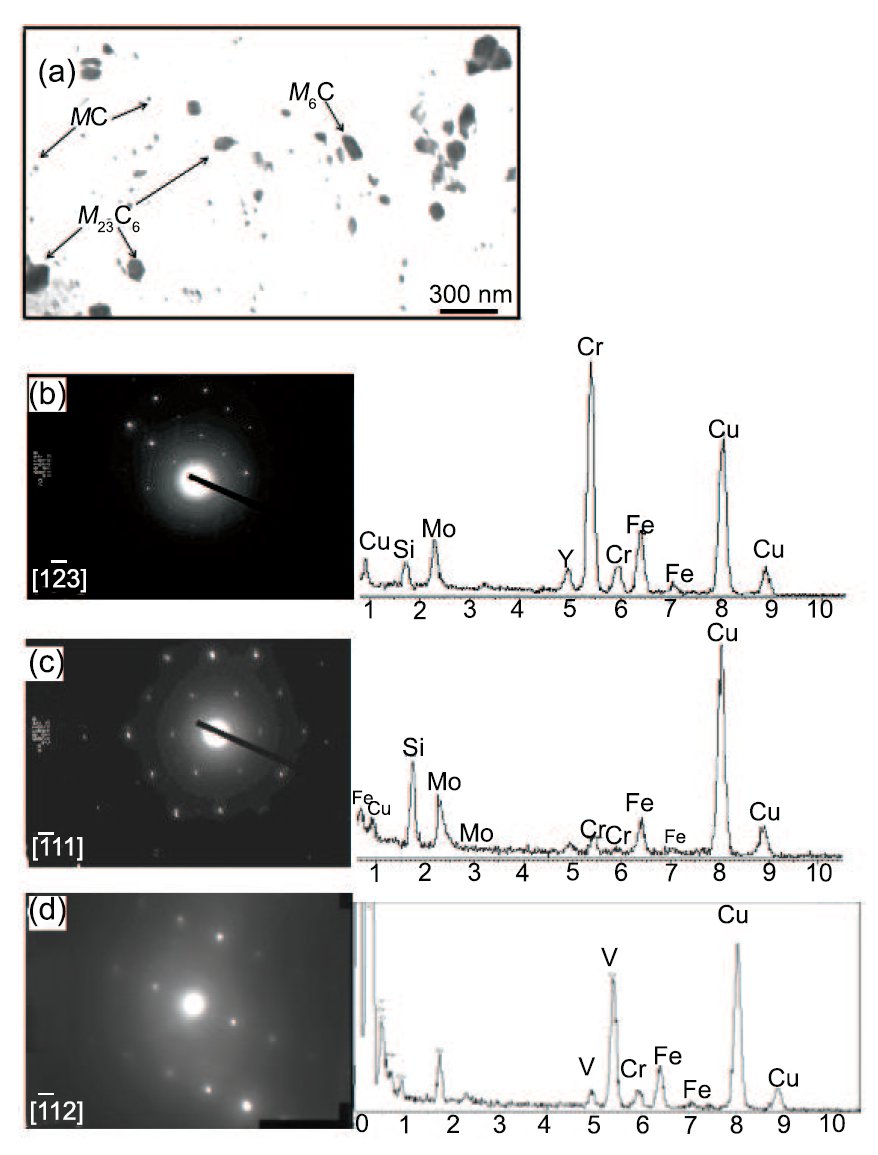
Alphabetical Index
Chemical Composition of Steels
Keyword Search
Steel Names
Alloyed Steels
Carbon Steels
Cast Irons
Chromium Steels
Cold Work Tool Steels
Creep Resistant Steels
Hot Work Tool Steels
Molybdenum Steels
PM steels
Stainless Steels
Structural Steels
Tool Steels
Vanadium Steels
White Cast Irons
M2C Carbides
M3C Carbides
M7C3 Carbides
M23C6 Carbides
MC Carbides
Light Microscopy
EDS/WDS Microanalysis
Scanning Electron Microscopy
Transmission Electron Microscopy
X-Ray Diffraction
Help
Contact Us
Home
M23C6, M6C and MC carbides in AISI H13 steel

Figure 1: Typical TEM micrographs of extraction replica and spectroscopy EDS results showing the various carbides
observed in H13 steel after heat treatment (unaged): (a) micrographs of extraction replica, (b) diffraction
patterns and spectroscopy EDS of irregularly sphere-like carbide M23C6, (c) diffraction patterns and
spectroscopy EDS of bar-like carbide M6C, (d) diffraction patterns and spectroscopy EDS of fine particle
carbide MC. Scale bar: 300 nm.
Carbide name: M23C6, M6C and MC
Record No.: 739
Carbide formula: M23C6, M6C and MC
Carbide type: M23C6, M6C, MC
Carbide composition in weight %: No data
Image type: TEM
Steel name: AISI H13
Mat.No. (Wr.Nr.) designation: 1.2344
DIN designation: DIN X40CrMoV51
AISI/SAE/ASTM designation: AISI H13
Other designation: No data
Steel group: No data
Steel composition in weight %: 0.36% C, 0.94% Si, 0.35% Mn, 0.08% S, 0.011% P, 5.06% Cr, 1.52% Mo, 1.03% V.
Heat treatment/condition: The material investigated was supplied in the size
of 60 mm x 80 mm blocks, which was vacuum melted
and forged. Afterwards, the material was austenitized at
1025±C for 30 min and quenched to room temperature,
followed by tempering twice at 610±C for 2 h.
The samples were isothermally aged at 700±C for 20,
60, 120, 240 or 480 min.
Note: Based on the local equilibrium assumption, coarsening behavior of M23C6 carbide at 700±C in H13 steel was
simulated by DICTRA software. The results from the calculations were compared with transmission electron
microscopy (TEM) observations. The results show the interfacial energy for M23C6 in H13 steel at 700±C is
thus probably 0.7 J x m(-2), which fits the experiments well. The influence of composition and temperature on
the coarsening rate was also investigated by simulations. Simulations show a decrease in the coarsening rate
when V/Mo ratio is increased, while the coarsening rate increases with increasing temperature.
M23C6 carbide consists of Fe, C, Cr, Mo and V.
The growth and coarsening are controlled by the diffusion
of the substitutional components Cr, Mo and
V. The simulation, which is rather complex and time
consuming, is therefore restricted to H13 steel with
the five major components.
Figure 1 shows the typical TEM micrographs of
extraction replica of H13 steel after tempering 2x2 h
at 610±C. Three carbides, M23C6, M6C and MC (as
shown by arrows, respectively), are identified by their
diffraction patterns and EDS spectra. The size of the
large carbides is round 1 µm and the small ones are
round 0.05 µm in diameter. These two distributions
are formed due to the heat-treatment. First, there
is an austenization at 1025±C and at this temperature
some carbides dissolve, but not all. The large
carbides remain undissolved, but they may dissolve
partially, whereas the small ones dissolve. At tempering
temperature a fine dispersion of carbides forms.
Hereafter the large particles will be called the primary
carbides and the small ones the secondary carbides.
Only coarsening of the secondary carbides will
be studied here because the coarsening of the large
particles is expected to be a much slower process and
has no important influence on the mechanical properties.
The irregularly sphere-like precipitates are identified
as M23C6 type with alloy elements of Cr, Fe,
Mo and small V. M6C precipitates are determined as
bar-like with mainly metallic elements of Mo and Fe.
In addition, MC carbides are also determined as fine
particle. The Cu peaks arise from the copper grids,
which support the replicas. Table 3 summarizes the
size and morphology of the carbides. 20»30 particles
were identified and measured for each condition.
Figure 3 shows the change of the size for M23C6 carbide
with ageing time. It is clear that
the M23C6 grows very fast during first 120 min, after
that, M23C6 grows with a lower rate.
Links: No data
Reference: Not shown in this demo version.